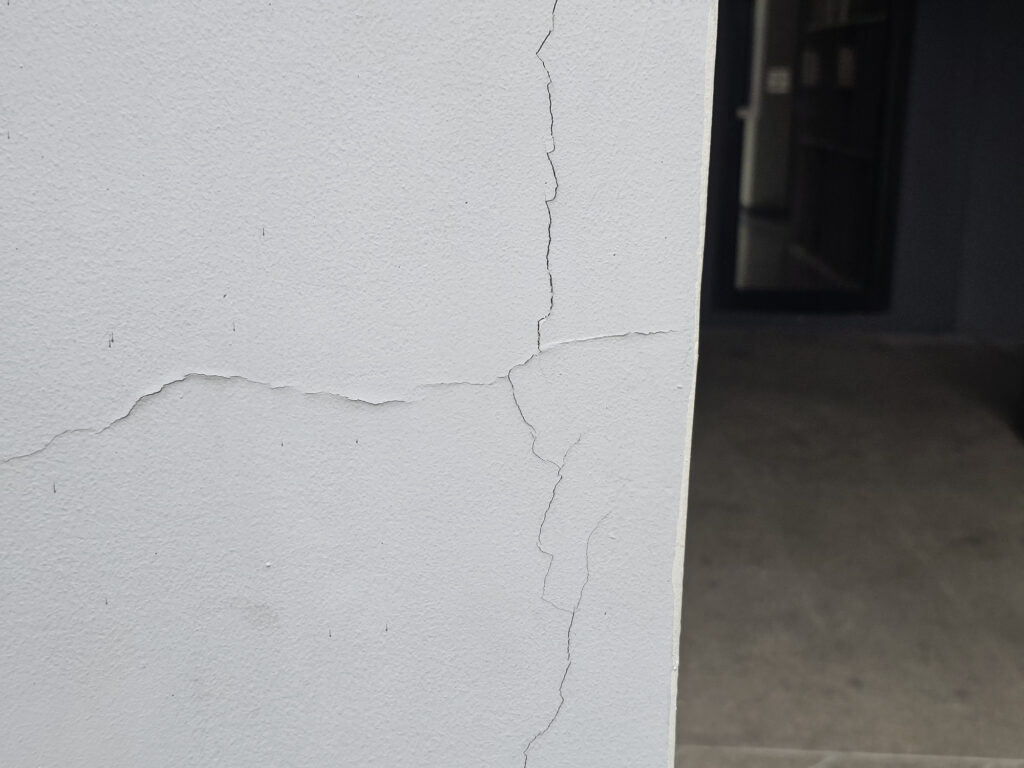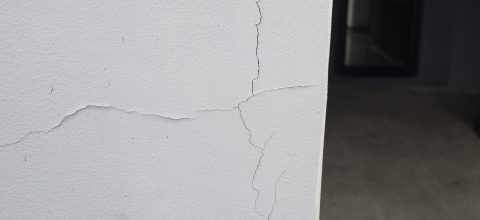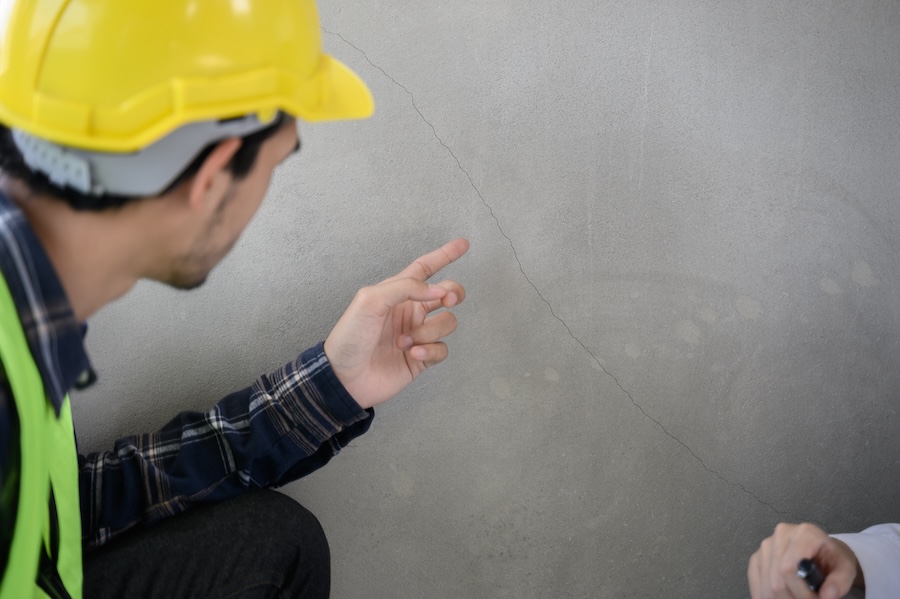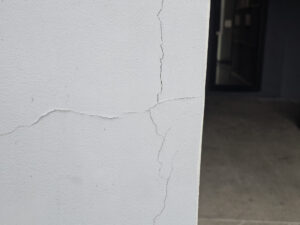A crack in your drywall is certainly a concerning sight. However, drywall cracks arise from different underlying sources. Some cracks require immediate attention while others are completely harmless. As a homeowner, it’s beneficial to understand the difference between the two.
The short answer: Yes, horizontal hairline cracks in drywall are typically problematic and often indicate serious structural problems that require professional evaluation, unlike vertical cracks, which are usually harmless cosmetic issues.
Signs Your Drywall Crack is Non-Structural
As noted above, some drywall cracks are benign and pose no threat to your home’s structural integrity. We refer to these cracks as non-structural. Here are a few signs that the cracks in your drywall are nothing to worry about:
Size and Pattern Indicators
- Hairline width: Most non-structural cracks are hairline crack patterns, meaning they are less than 1/8 of an inch wide. These small crack formations typically develop from normal settling.
- Vertical direction: Non-structural wall cracks are often vertical crack formations and can be caused by minor shifts in building materials or joint compound settling during the curing process.
- Minimal spread: Non-structural cracks typically consist of a small crack that does not branch and spread across the drywall surface.
Location-Based Clues
Common locations for harmless drywall damage include:
- Cracks along drywall seams where panels meet
- Minor cracking near door frame areas
- Small fissures around window frames
- Hairline cracks at ceiling joints
Both newer homes and older homes can experience these cosmetic issues as building materials naturally expand and contract with temperature changes.
If your crack proves to be non-structural, it’s nothing more than a cosmetic concern. Non-structural cracks do not require extensive foundation repair, and you or a professional can easily conceal them with simple drywall damage repair techniques.
Signs a Crack Results from Structural Damage
While some wall cracks are non-structural and therefore non-worrisome, other cracks indicate significant damage that threatens the structural integrity of your entire home. We refer to these concerning cracks as structural cracks. Below are key signs that your drywall cracks require professional attention as soon as possible:
Direction and Size Warning Signs
- Horizontal direction: Nearly every horizontal crack that runs along an exterior wall or interior surface indicates a severe structural problem requiring immediate foundation repair contractor evaluation.
- Width greater than 1/8 of an inch: Larger cracks are usually wider than ⅛ inch and may indicate foundation settlement or foundation settling issues affecting the entire structure.
- Varying width: Non-structural cracks have consistent width, while structural problem cracks can be wider cracks at one end, suggesting ongoing movement.
Visual Distortion Symptoms
- Wall distortion: When drywall not only has cracks but also walls bow and become misshapen, this indicates serious structural problems with the foundation wall or wood framing system.
- Increasing size: Structural movement causes cracks that worsen and get bigger over time, leading to further damage throughout the home.
Pattern Recognition
- Multiple cracks: While a single vertical crack is usually harmless, multiple wall cracks near each other typically indicate foundation issue concerns.
- Stair-step crack patterns: For those with masonry foundations, stair-step crack formations following mortar patterns indicate foundation damage.
- Diagonal crack formations: Like horizontal and stair-step patterns, large diagonal crack formations often signal structural movement in the home’s foundation.
Water Infiltration Issues
Cracks allowing water damage from outside indicate foundation problem severity requiring immediate structural engineer assessment. Water intrusion suggests the crack extends through multiple layers of the building envelope.
Understanding the Connection
Foundation problems translate to drywall issues through a chain reaction. When soil conditions affect the home’s foundation stability, movement occurs in the concrete slab and foundation wall. This structural movement travels upward through the wood framing, eventually manifesting as cracks in the drywall.
Plaster walls and modern drywall systems respond differently to structural stress, but both will show similar warning patterns when foundation damage occurs.
Understanding these signs will help you know when to seek professional help. However, it’s best to be safe rather than sorry. If you cannot tell if your cracks are structural or non-structural, it’s always wise to seek a professional’s opinion.
Why Horizontal Drywall Cracks Are Problematic
If you discover a horizontal crack in your drywall, especially along an exterior wall, you should assume it is a problematic structural crack requiring repairs. Even if your horizontal crack is a hairline crack, it most likely arises from a foundation issue.
Foundation Movement as the Primary Cause
Foundation movement creates the most common source of horizontal crack development. Here’s how the process typically unfolds:
- Initial foundation settling occurs as soil conditions change beneath the home
- Foundation wall displacement begins, often starting at weak points
- Structural movement transfers through the wood framing system
- Drywall cracking appears as the final visible symptom
Soil and Environmental Factors
Several environmental conditions contribute to foundation problems that lead to wall cracks:
- Expansive soil conditions that swell and shrink with moisture changes
- Water damage from poor drainage around the foundation
- Settling issues that develop gradually over years
- Seasonal ground movement affecting concrete block and foundation wall stability
Why Horizontal Patterns Signal Danger
Horizontal crack patterns specifically indicate that the foundation wall is experiencing lateral pressure or movement. Unlike vertical cracks that often result from normal settling, horizontal cracks suggest:
- The foundation wall is bowing or shifting laterally
- Soil pressure is pushing against the foundation
- Structural integrity has been compromised at the foundation level
- The home’s weight distribution has become uneven
Sometimes improper drywall installation can initially mask underlying foundation issues, but structural problems will eventually overcome cosmetic repairs and reappear.
Horizontal crack patterns compromise the structural integrity of your foundation and jeopardize the stability of your entire home, making professional evaluation necessary to prevent serious structural problems from worsening.
Professional Solutions and AMC911’s Expert Approach
When you have a horizontal crack in your drywall, reach out to a professional foundation repair team. Even if your horizontal cracks are thin, chances are they result from a severe issue that requires expert attention.
For over 30 years, AMC911 has provided engineered solutions to foundation problems throughout the Hampton Roads region. As Class A contractors with an A+ Better Business Bureau rating, we bring unmatched expertise to every structural problem we encounter.
What sets AMC911 apart:
- In-house engineering team that designs custom solutions for each foundation issue
- Comprehensive approach addressing both immediate repairs and long-term prevention
- Specialized focus on foundation repair, waterproofing, and structural solutions
- Family-owned commitment to treating every home like our own
Our team understands that a strong foundation paves the way to better living. When we evaluate horizontal drywall cracks, we’re not just looking at surface damage. We’re examining your home’s entire structural system to ensure lasting stability.
Why Professional Foundation Work Matters
Foundation repair requires specialized knowledge, equipment, and materials that go far beyond typical home improvement projects. Our engineered solutions address the underlying structural problems causing your drywall cracks, providing peace of mind through expert evaluation and comprehensive repair.
Don’t let horizontal cracks in your drywall become a bigger problem. If you’re dealing with concerning wall cracks in Virginia Beach, Chesapeake, Norfolk, or surrounding Virginia areas, reach out to AMC911. We have over 30 years of experience providing engineered foundation solutions that protect your home’s structural integrity.
Contact us today to learn how we can resolve your foundation concerns and restore your confidence in your home’s stability.



















